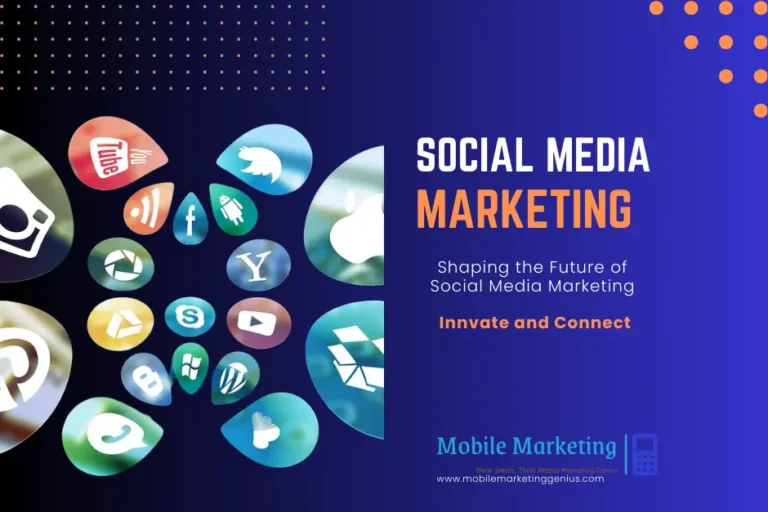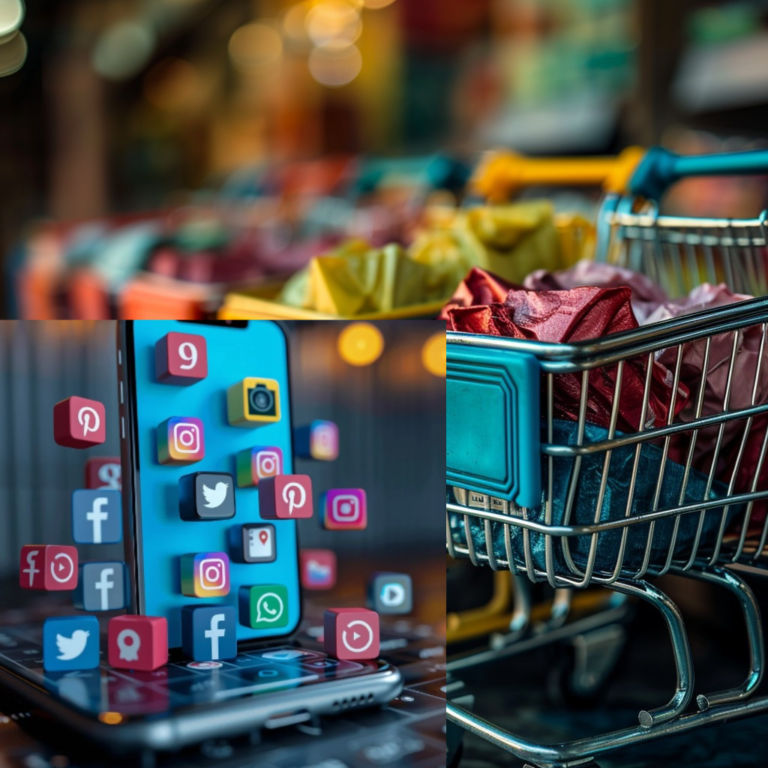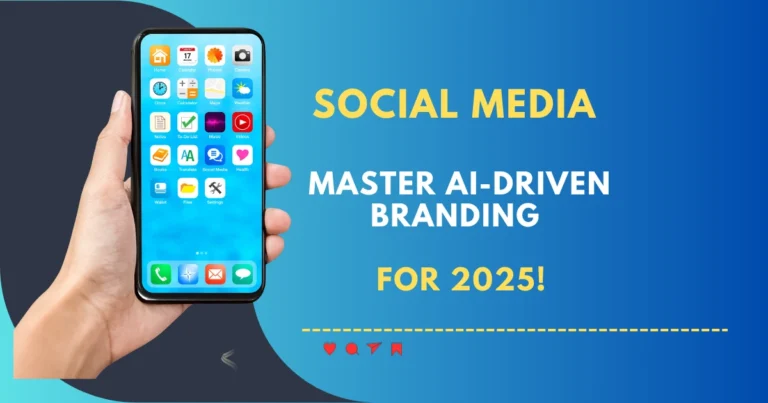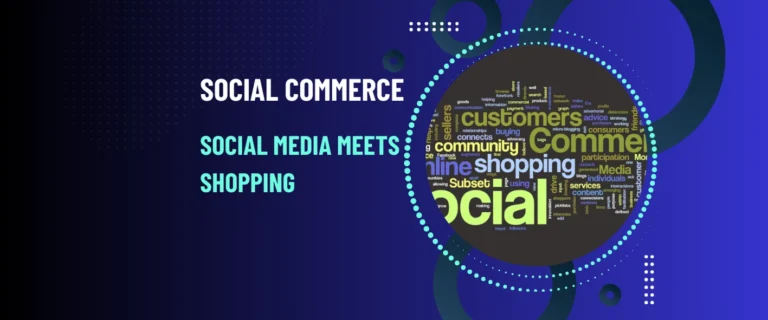Harnessing the Power of Social Media in Mobile Marketing: Strategies for Success

As highlighted in previous articles on this blog, the rise of mobile usage has drastically transformed the digital marketing landscape. With over 4.8 billion people using mobile devices globally, it’s no surprise that social media has become a crucial element in mobile marketing strategies.
According to recent studies, around 98% of Facebook users access the platform through mobile devices, and Instagram has reported that over 70% of its users engage with the platform exclusively via mobile. For TikTok, over 90% of users access the platform through mobile devices. For X (formerly known as Twitter), approximately 80% of its users access the platform via mobile devices. These statistics emphasize the need for businesses to adopt a social media in mobile marketing approach to stay competitive in the digital age. But what makes social media such a powerful tool for mobile marketing, and how can brands effectively leverage it? T
his article delves into the top strategies, benefits, and practical tips for utilizing social media in mobile marketing to achieve better results.
Table of Contents

1. What Makes Social Media a Game-Changer in Mobile Marketing?
The integration of social media in mobile marketing has fundamentally changed how businesses interact with their customers. Unlike traditional marketing channels, social media allows for instant and real-time engagement, enabling brands to reach customers wherever they are. This capability is crucial, as recent reports indicate that 91% of social media users access these platforms via mobile devices, making it easier for brands to deliver targeted and personalized content.
One key advantage of this integration is the availability of advanced analytics tools that social media platforms offer. These tools provide insights into user behavior, preferences, and engagement patterns, allowing businesses to tailor their mobile campaigns with precision. For example, Instagram and TikTok algorithms prioritize content that resonates with users’ past interactions, enhancing the effectiveness of mobile-first marketing efforts and increasing reach.
2. Top Benefits of Integrating Social Media with Mobile Marketing
- Increased Reach
- With most users accessing social media through mobile devices, social media in mobile marketing enables brands to tap into vast user bases. Platforms like TikTok have reported a staggering 1 billion active users globally, and Facebook has over 2.9 billion monthly active users. This widespread usage allows brands to target various demographics with precision.
- The mobile nature of these platforms facilitates easy content sharing, allowing users to spread content quickly among their networks. This can lead to viral campaigns that significantly boost brand awareness.
- Enhanced User Engagement
- One of the greatest strengths of social media in mobile marketing is its ability to create highly engaging experiences for users. Features like Instagram Stories, Facebook Reels, and TikTok challenges allow brands to interact with users in real time, fostering a sense of community.
- Interactive content, such as polls, quizzes, and live streams, is especially effective in capturing mobile users’ attention. Studies show that short-form videos have an average engagement rate of 55%, making them an essential part of any social media strategy aimed at mobile engagement.
- Cost-Efficiency
- Implementing a social media strategy offers businesses a cost-effective way to promote their products and services. In comparison to traditional advertising channels, running ads on social media is often more affordable, especially when targeting mobile users.
- With platforms like Facebook and Instagram offering advanced ad targeting options, businesses can focus their ad spend on the most relevant audiences. For example, mobile-specific ad formats like Stories and Reels are designed to capture attention quickly, making them ideal for mobile-first marketing campaigns.
- Better Conversion Rates
- Mobile users are more likely to engage directly with brands through social media ads, which streamlines the conversion process. For instance, Instagram’s shoppable posts and TikTok’s in-app shopping feature provide a direct path for users to explore and purchase products without leaving the app.
- Additionally, user-generated content plays a pivotal role in driving conversions. According to a study by Nielsen, 92% of consumers trust recommendations from friends and other users over brand advertisements, making authentic content an effective way to build trust and drive sales.
3. Strategies for Effective Use of Social Media in Mobile Marketing
- Optimize Content for Mobile Devices
- Mobile users have different needs than desktop users, so it’s essential to create content optimized for small screens. This includes using high-resolution images, short-form videos, and concise text that are easy to view on the go.
- Videos, in particular, have proven to be highly effective for mobile audiences. A recent study found that 72% of consumers prefer to learn about a product through video, making it a crucial component of any mobile-first marketing strategy.
2. Leverage Mobile Ads
- Platforms like Facebook, Instagram, and TikTok offer various ad formats tailored specifically for mobile. For example, TikTok’s In-Feed ads blend seamlessly with organic content, making them less intrusive and more engaging for users.
- Implementing social media ads allows brands to reach highly targeted audiences based on demographics, interests, and behaviors. Instagram’s advertising algorithms can deliver ads directly to users who have shown interest in similar content, resulting in higher engagement and conversion rates.
- Use Stories and Short Videos
- Stories have become a popular way for users to share content, and brands can leverage this feature to engage mobile audiences effectively. Instagram Stories and Facebook Stories are perfect for sharing behind-the-scenes content, product launches, and limited-time promotions.
- Short videos on TikTok or Instagram Reels are especially useful for grabbing attention quickly. Brands should aim to deliver their message within the first few seconds to retain user interest and drive engagement.
- Engage with User-Generated Content
- Encouraging users to create content related to your brand can significantly enhance authenticity and trust. User-generated content (UGC) such as reviews, unboxing videos, and customer photos can be repurposed across social media channels to build credibility.
- Brands can run campaigns that incentivize UGC—such as challenges or photo contests—to encourage more interaction from their audience. This helps in creating a community around the brand, leading to increased loyalty and engagement.
4. Case Studies: Brands That Mastered Social Media for Mobile Marketing
- Nike’s TikTok Challenge
- Nike’s TikTok challenges have become a benchmark for successful social media in mobile marketing. By encouraging users to showcase their athletic abilities through creative challenges, Nike effectively engages a young, mobile-savvy audience.
- The campaign’s success lies in its focus on user-generated content, creating a sense of community and fostering long-term brand loyalty. This approach not only increased brand visibility on TikTok but also enhanced customer engagement through a fun and interactive experience.
2. Starbucks’ Instagram Stories Campaign
- Starbucks leverages Instagram Stories to promote new drinks, engage with seasonal content, and showcase user-generated content such as customer photos. The brand uses interactive elements like polls, quizzes, and Q&A sessions, significantly boosting mobile engagement.
- By keeping its content fresh, interactive, and mobile-focused, Starbucks has maintained a strong presence among mobile users, ensuring that followers remain engaged and frequently interact with its posts.
3. Coca-Cola’s #ShareACoke Campaign
- Coca-Cola’s #ShareACoke campaign is a classic example of effective social media in mobile marketing. The campaign invited users to find Coke bottles with their names on them, take photos, and share them on social media with the hashtag #ShareACoke.
- The campaign’s mobile focus was evident, as users were encouraged to share their photos directly from their mobile devices. This approach significantly boosted user-generated content, with thousands of posts shared across Instagram, Facebook, and Twitter. Coca-Cola reached a younger demographic and reignited interest in the brand, all while seeing a surge in mobile engagement.
- The simplicity of the campaign, combined with its focus on making users feel like part of the brand’s story, helped drive both engagement and sales.
4. Airbnb’s Instagram and TikTok Strategy
- Airbnb has effectively used social media in mobile marketing through visually appealing content on Instagram and TikTok, highlighting unique travel experiences and accommodations. Recognizing that a large portion of its audience engages with social media on mobile, Airbnb ensures its content is mobile-friendly, using captivating videos and high-quality images.
- Airbnb’s TikTok account features short clips of stunning vacation spots, user testimonials, and travel tips, appealing to younger users looking for inspiration. By collaborating with influencers, Airbnb enhances its social media strategy, reaching niche audiences and increasing brand visibility on mobile-focused platforms.
- This approach has improved Airbnb’s mobile engagement and helped grow its follower base on Instagram and TikTok, leading to more app downloads and direct bookings through mobile.
5. Domino’s Pizza’s “AnyWare” Campaign
- Domino’s Pizza has long been a leader in using social media in mobile marketing to simplify customer experiences. With their “AnyWare” campaign, Domino’s enabled customers to place orders from almost any device, including social media platforms like Twitter and Facebook Messenger.
- A standout feature was the ability to order via Twitter by tweeting a pizza emoji to Domino’s Twitter account. This campaign embraced mobile-first marketing, understanding that users increasingly interact with brands through smartphones.
- The “AnyWare” campaign resulted in significant mobile engagement, boosting app downloads and orders. It showcased the power of creating a seamless customer journey directly from social media to mobile ordering, making the process convenient for users.
Each of these brands has successfully harnessed the power of social media in mobile marketing, utilizing mobile-friendly strategies, user-generated content, and innovative campaigns to engage audiences and drive business growth.

5. Challenges in Using Social Media for Mobile Marketing
Despite the numerous benefits, social media in mobile marketing does come with challenges. Algorithm changes on platforms like Instagram and TikTok can significantly affect the reach of organic content, making it difficult for brands to maintain visibility. Additionally, privacy concerns and evolving data regulations limit the ways brands can target users, requiring continuous adjustments to strategies.
However, brands can overcome these challenges by diversifying their social media presence across multiple platforms and focusing on building authentic relationships with their audiences. Transparency about data usage and a focus on providing genuine value can help maintain trust with users.
6. Future Trends: The Evolution of Social Media in Mobile Marketing
As technology advances, the potential of social media in mobile marketing continues to grow. Emerging trends like AI-powered chatbots, augmented reality (AR) shopping experiences, and live-streaming offer new ways to engage mobile users. Platforms like Instagram and Snapchat have already integrated AR filters that enable users to try on products virtually, making shopping more interactive.
Live-streaming is becoming increasingly popular, with platforms like Instagram Live and TikTok Live offering real-time interaction opportunities. According to recent data, live-stream shopping is expected to generate over $500 billion in global sales by 2025, making it a key area for brands to explore.
7. Conclusion
In conclusion, social media in mobile marketing offers unprecedented opportunities for businesses to reach and engage their audiences. By optimizing content for mobile, leveraging targeted ads, and utilizing user-generated content, brands can ensure a strong mobile presence and stay competitive in the digital age. As mobile usage continues to grow, a robust social media strategy is essential for any business aiming for long-term success.
Whether you’re a small business or a large enterprise, adopting a mobile-first marketing approach will help you connect with customers on their preferred devices. Start implementing these strategies today, and watch your brand’s mobile engagement soar.






2 Comments
Comments are closed.